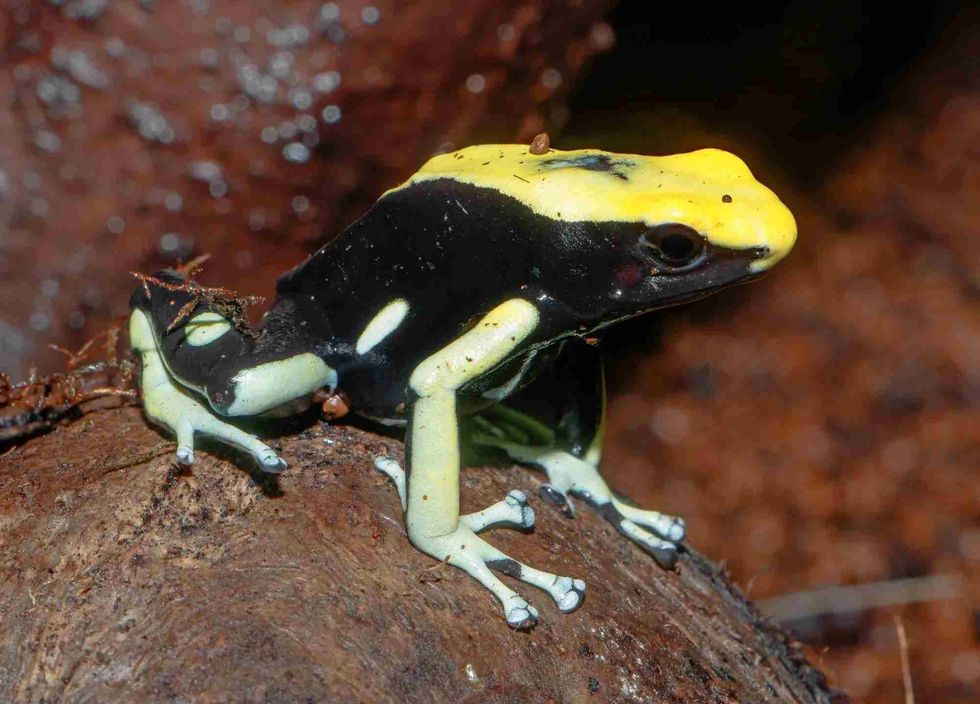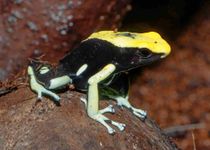If you are fascinated by poison frogs, then here we have all the dyeing poison dart frog information. The dyeing dart frog (scientific name: Dendrobates tinctorius) is a species of poison dart frogs that are native to South America.
It can be seen in Brazil, French Guiana, and Suriname. The primary habitat of the species is wet or humid areas.
It procreates on land but raises its young ones and spends a large part of its life in water. Like most other poison dart frogs, dyeing poison dart frog also has a brightly colored body. They secrete a kind of poison that helps them evade their predators.
They are carnivorous animals, and their diet consists of small insects like ants, termites, and more. This diet also includes small spiders.
Myths say that these frogs were once used to turn the feathers of parrots from green to red. That's how they got their name as the dyeing poison dart frog.
For more relatable content, check out these tree frog facts and African bullfrog facts for kids.
Dyeing Dart Frog Interesting Facts
What type of animal is a dyeing dart frog?
Dyeing poison dart frogs are a species of poison frogs.
What class of animal does a dyeing dart frog belong to?
The dyeing dart frog belongs to the class Amphibia of animals.
How many dyeing dart frogs are there in the world?
The exact population of the dyeing poison dart frog in numbers is not known. However, their population seems to have a stable trend. Even though in most of their habitat range, their population is spread patchily, the population is distributed evenly in the country of French Guiana.
Where does a dyeing dart frog live?
This species can be found in the northeastern part of South America. They mainly live in the countries of Guyana, Brazil, Suriname and the geographical range of the frogs also includes French Guiana.
What is a dyeing dart frog's habitat?
The primary habitat of the species is wet and humid areas. They can be found around heavy vines in their habitat, at least a few feet above the ground or under mossy rocks.
These frogs can be seen within the forests of South America. Usually, these forests are separated by a high plateau or dry savannah, so the habitat of the frogs gets heavily distributed, limited only within the wet areas of the forests.
Who do dyeing dart frogs live with?
Dyeing poison dart frog is a social frog. These frogs are known to stay in pairs and groups in the daytime. Unlike many other frogs, these frogs are diurnal.
How long does a dyeing dart frog live?
Not much is known about the lifespan of the dyeing poison dart frog living in the wild habitat, but some that are living in a zoo have been known to live for about five years or so.
How do they reproduce?
We do not really know much about the breeding season of the dyeing dart frog reproductive system. When the frogs are ready to mate, males call out, and females follow the sound.
The mating process is known to happen on land. The female lays 8-15 eggs, and the male is then known to fertilize them.
The initial parental care of the eggs and larvae is done by males. When the eggs hatch, the male carries the larvae or tadpoles on its back to a preferred water hole, where the male releases them. Many males might release several larvae or tadpoles in one single water hole.
The competition between the siblings can get brutal to the point that they kill or feed on each other. The surviving ones reach their transformational size within the following ten weeks.
The frog family stays near the water site until the tadpoles are mature enough for about a year or so. Then adult frogs go on to live their lives on land.
What is their conservation status?
The conservation status of the dyeing poison dart frog, according to the International Union for Conservation of Nature, is listed as Least Concern.
Dyeing Dart Frog Fun Facts
What do dyeing dart frogs look like?
The dyeing poison dart frog is a big-sized poison frog. They are generally bright blue-colored with two bright yellow stripes running on their back.
These two stripes cross each other at times and make a few bright blue oval patterns on the back. Sometimes these stripes may take up a lot of space, and the pattern may be solid yellow or sometimes even white on an otherwise bright blue-back. The limbs are of dark blue or black-colored with black and yellow spots.
How cute are they?
These frogs might look extremely attractive due to their bright colors. They are also kept as pets by many but don't get fooled as they are poisonous.
How do they communicate?
These frogs communicate chemically and vocally. Only males call during the breeding season to attract females. On the other hand, these frogs are known to be poisonous. By secreting the toxic substance, they defend themselves from the dyeing poison dart frog predators.
How big is a dyeing dart frog?
The dyeing dart frog size is about 1.5-2 in (3.8-5 cm). They are slightly smaller than pool frogs, which are about 1.9-3.5 in (5-9 cm) in length.
How fast can a dyeing dart frog move?
The speed at which the dyeing poison dart frog moves is not known, but they are known to move at a moderate pace.
How much does a dyeing dart frog weigh?
A dyeing poison dart frog weighs about 0.1-0.2 oz (2.8-5.7 g).
What are the male and female names of the species?
Males and females of the species have no specific names.
What would you call a baby dyeing dart frog?
A baby dyeing poison dart frog is known as a larva or tadpole.
What do they eat?
This species is carnivorous in nature. The dyeing dart frog diet consists of small insects, ants, like the leafcutter ants, termites, and more. Apart from ants, termites, the diet also includes small spiders.
How far can they jump?
Frogs, in general, have the ability to jump more than 40 times their body length.
Would they make a good pet?
These frogs are known to be kept as pets. They are not high maintenance, and their bright colors attract many people. However, you should handle it with caution.
Did you know...
Even though the species is known to be poisonous, it's assumed that they get the toxic substance due to their diet in the wild habitat. The ones that are born in captivity don't have the same diet as the wild ones and, interestingly, are not known to be toxic.
Some dyeing poison dart frog morphs are Dendrobates tinctorius' giant orange', Dendrobates tinctorius' azureus', or Dendrobates tinctorius' patricia'.
Can a poison dart frog kill you?
Some species of poison dart frogs are able to kill humans, and some species of poison dart frogs are not. If poison dart frogs are handled roughly, they might secrete the toxic substance to defend themselves which might cause problems.
Dyeing dart frog mating
The males of the species are known to call when they are ready to mate, and the females come to the males in response. They breed on land. The females lay the eggs, and the males fertilize them.
Here at Kidadl, we have carefully created lots of interesting family-friendly animal facts for everyone to discover! For more relatable content, check out these pool frog facts and blue poison dart frog facts pages.
You can even occupy yourself at home by coloring in one of our free printable dyeing dart frog coloring pages.








